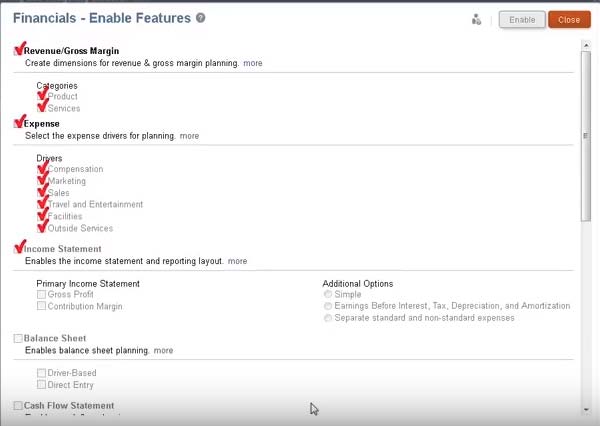After enabling the Financials framework, which three are recommended configuration tasks? (Choose three.)
ABD
A:

B: Planning and Forecast Preparation
You can configure the timeframe and granularity for plans for each business process. Configuration settings are stored separately, so you can have a different timeframe and granularity for each business process and for each year.
D:

References:
Configuring Financials in Oracle Enterprise Planning and Budgeting Cloud https://www.youtube.com/watch?v=aZjMGLMKmxQ https://docs.oracle.com/cloud/latest/pbcs_common/EPBCA/ common_configure_planning_and_forecase_preparation_with_rolling_forecast_100xa365356d.htm#EPBCA-GUID-D2F62AA0-D221-4380-A392-0670B87B324A
When importing data into the Financials framework, which Plan Element dimension member should be selected to help keep track of the cube’s data sources?
When importing data into the Financials framework, the Plan Element dimension member 'OFS_Load' should be selected to help keep track of the cube’s data sources. This member is specifically designed to manage and track data imports, ensuring that the source and integration process are easily identifiable and manageable.
Which two components can be installed on the administrator’s computer to support Planning and Budgeting Cloud (PBCS)? (Choose two.)
To support Planning and Budgeting Cloud (PBCS), an administrator can install Strategic Modeling and EPM Automate on their computer. Strategic Modeling is required for strategic planning processes, and EPM Automate is a utility that allows administrators to perform various tasks remotely. Other options like Calculation Manager and the Simplified User Interface are not components that need to be installed on the administrator’s computer.
Which three items would be in appropriate use case for "Data Management" in Enterprise Planning and Budgeting Cloud (EPBCS)? (Choose three.)
Enterprise Planning and Budgeting Cloud (EPBCS) offers comprehensive data management capabilities that align with different use cases. 'Drill-back' capabilities allow for detailed analysis of data, making option A suitable. The ability to load data to their application via flat files is also a common requirement in data management, supporting option B. Finally, the ability to map data from multiple chart string segments to a single dimension allows for efficient management and aggregation of financial data, making option E appropriate. While processing data from multiple chart of accounts might seem relevant, specific mapping to dimensions (option E) aligns better with common data management practices.
Which three are use cases for data maps? (Choose three.)
Data maps are used to integrate and push data between different cubes and plan types within financial systems. They are useful for transferring data from a planning cube to a reporting cube, integrating data between custom plan types and business frameworks, and integrating data between various business frameworks. They do not provide functionalities for drilling back to data in a different cube, nor are they used to create replicated partitions between cubes. Thus, the use cases for data maps are correctly identified as integrating and pushing data across different types and frameworks.